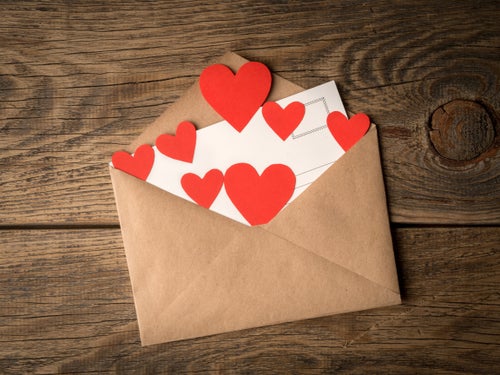

With the likes of Benedict Cumberbatch, Carey Mulligan, Sally Hawkins, Colin Firth and Juliet Stevenson performing live renditions of letters past to packed-out venues, the letter is in rude health among both A-list actors and the public consciousness. Many of their readings are love letters, including correspondence between Napoleon and Josephine, Katharine Hepburn and Spencer Tracy, and a heartrending exchange between a mother and JK Rowling.
Alas, the inspiration from these famous letters only travels so far. Royal Mail recently conducted a poll suggesting that more than 40% of us are apprehensive about being mocked for expressing our affections through the post, and almost one-fifth said they were uncertain how to structure a letter. A further five percent were even worried about their poor handwriting. And yet, out of the 2,000 people surveyed, over a third expressed a desire to write a love letter. So I’ve been working with Royal Mail on a list of 25 tips that may lessen their fears and improve their chances of success.
Some of them are obvious – don’t refer to previous dalliances, and avoid scary green ink – but others may be less so: take your time, don’t be needy and remember your sense of humour. And write sober – or if you want to write drunk one night, check it over with your hangover before sending the next morning.
Then there are some more specific suggestions. It’s OK to borrow some words from the similarly smitten – Beethoven perhaps, writing to his immortal beloved: ‘Never another one can own my heart, never – Never!’ Or take some clues from the famous letter Johnny Cash wrote to his wife June Carter Cash for her 65birthday in 1994 (he admitted that sometimes they irritate each other, and perhaps take each other for granted, but he ended with a flourish: ‘You influence me for the better, the #1 Earthly reason for my existence.’) And you can’t go wrong if you follow the advice of Jane Austen, who believed that you should write as you speak – naturally, faithfully.
“Write as if your words will be clutched to your recipient’s heart for ever and a day.”
Do use the letter format to its full extent. The joy of not writing on a screen, where every pixel looks the same, is the ability to stamp your personality. If you feel that no personal communication can possibly be complete without an emoji, then design and send your own. Or get artistic in other ways - Charles Schulz wrote secret messages to his loved one embedded in his Peanuts strips. And why not restore to its rightful place the long-lost back-of-the-envelope SWALK? If you need to ask what it stands for, ask your mum. But it’s probably best to avoid the scented notepaper these days: not every recipient, or every postal worker, will share your taste in citrus topnotes.
Writing these hints I thought of myself as a latter day Charlie Brown, who once observed, ‘There must be millions of people all over the world who never get any love letters… I could be their leader!’ So I carried on. Be sincere: no pressure, but write as if your words will be clutched to your recipient’s heart for ever and a day. Make an effort with the stationery: it won’t turn you into Byron or Shelley, but it may improve your prose. And be sensible: don’t heed the advice of a Chinese writing guide from 1938 suggesting that love letters should be accompanied by a basket of fish.
My own favourite love letters go way back, beginning with Keats writing to Fanny Brawne in 1819, and Robert Browning writing to Elizabeth Barrett in 1845 (‘Dear Miss Barrett, I shall just say, in as few words as I can, that you make me very happy’.) But then of course I have letters of my own, sent by an early love in my late teens, still in a shoebox, hardly opened since the day they were sent, awaiting full embarrassing discovery by my children in future years.
The pleasure to be gained from receiving a personal letter in the digital age is immense, one of the simplest gifts of kindness one can bestow. A letter suggests to your crush that you’re serious, or it shows you don’t take your longer-term partner for granted. It’s also something that lasts. It’s unlikely we’ll ever discover love emails in an attic. I’ve always been inordinately fond of a phrase written by Katherine Mansfield at the beginning of the last century that manages to sum up the inherent value of any heartfelt personal correspondence: ‘This is not a letter,’ she writes, ‘but my arms around you for a brief moment’. And as Ms Mansfield surely knew, the last 1 class posting opportunity for Valentine’s Day this year occurs on 13 February.